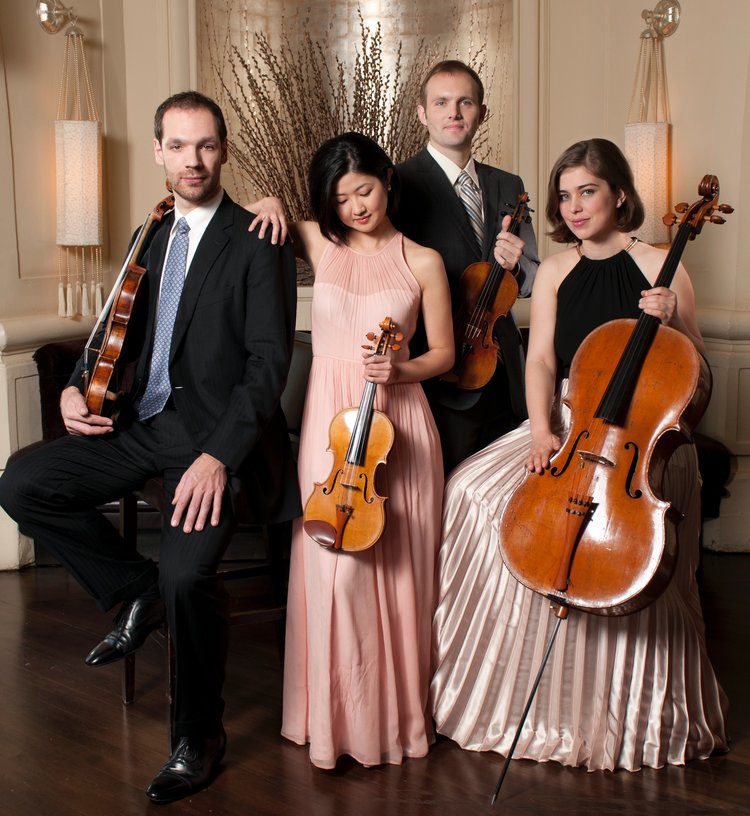
By Dennis D. Rooney
Jasper is the name of a gemstone and also a national park in Alberta, Canada, from which the Jasper String Quartet takes its name. The Jaspers are current artists-in-residence at Temple University in Philadelphia.
Previously quartet-in-residence at Oberlin College, where it was founded in 2006, it has won many awards, including the Cleveland Institute of Music’s Cleveland Quartet Award, the Fischoff Chamber Music Award’s Silver Medal, and was the first instrumental ensemble ever honored with the Horatio Parker Memorial Prize by the Yale School of Music.
On its Wednesday afternoon program at the Duncan Theatre’s Stage West, the Jasper offered quartet staples and novelties. The acoustics of Stage West are clear but dry, better suited to speech than to music. This was brought home sharply by the opening measures of Haydn’s Op. 76, No. 1, in G. Whatever its putative gain in intimacy, the room exposed a lack of warmth in first violinist J Freivogel’s tone. As the four voices made their entrance, it was clear that their ensemble was immaculate but the sound they made was often too loud and had an aggressive edge that wasn’t their fault.
This is a space in which to explore p to ppp, especially in the Adagio sostenuto, where true innigkeit is attainable, and the Trio of the Minuet, which was otherwise notable for their skill in unanimously executing dynamic accents. The Allegro ma non troppo finale seemed slightly phlegmatic and would have benefited from greater virtuosic flair.
The first of the two new works that followed was by Caroline Shaw (b. 1980), a violinist and composer who was the youngest recipient of the Pulitzer Prize in Music when she received it in 2013 at age 30. She describes her short work for string quartet, Valencia, as “the perfection of an orange.” It is entirely coloristic, filled with ostinatos, harmonics, glissandos, snap (or Bartókian) pizzicatos and conventional ones. Amid all these effects, an errant cellphone in the audience had a ringtone that seemed momentarily part of the soundscape before more homophonic textures brought the piece to a close.
Missy Mazzoli (b. 1982) is another American woman composer whose works have been praised, most notably her opera Breaking the Waves, which was enthusiastically lauded at its premiere in Philadelphia last September. Death Valley Junction, like Shaw’s work that preceded it, is also short, coloristic and impressionistic in its parade of instrumental effects.
The title, as explained by violist Sam Quintal in some prefatory remarks, refers to the California town, just outside Death Valley National Park, that is home to the Amargosa Opera House, which from 1968 to 2012 offered regular performances of opera and dance featuring Marta Becket, who often performed alone, persisting in her efforts in that remote place despite many evenings when the house was empty. It is a remarkable story. Perhaps Mazzoli will treat it operatically someday.
Her piece begins with an evocation of the harsh climatic conditions of the location and is followed by “a raucous dance.” However, the dance scene eventually gives way to delicate and elegiac conclusion.
One of the stalwarts of the quartet literature concluded the Jasper program. Debussy’s Quartet in G minor (Op. 10) is one of the most familiar and most approachable works in the genre. When first performed in 1893, it displeased some of its hearers who found its use of pizzicato and muted passages very unconventional; which was entirely Debussy’s purpose. The four-movement structure thematically liked in the cyclical manner of César Franck was also a bone of contention.
Today, its voice leading, sometimes almost orchestral in texture, and the lush sonorities that emerge from every page have made it an overwhelming audience favorite. In its performance, the Jasper supplied strength but fell short on tonal finesse. Impassioned passages became raucous, having the hard-driving manner of the Tokyo Quartet of old, although the room acoustics were at least in part to blame.
Nevertheless, In the Andantino’s con sordino opening, the second violin and viola intoned the material with portamento but cellist Rachel Henderson Freivogel, when she had to play it, seemed to shy away from slides and sounded slightly clumsy instead.